Information
LHCb-DP-2023-002
arXiv:2310.05864 [PDF]
(Submitted on 09 Oct 2023)
JINST 19 (2024) P02010
Inspire 2709160
Tools
Abstract
The identification of helium nuclei at LHCb is achieved using a method based on measurements of ionisation losses in the silicon sensors and timing measurements in the Outer Tracker drift tubes. The background from photon conversions is reduced using the RICH detectors and an isolation requirement. The method is developed using $pp$ collision data at $\sqrt{s}=13 {\rm TeV}$ recorded by the LHCb experiment in the years 2016 to 2018, corresponding to an integrated luminosity of $5.5 {\rm fb}^{-1}$. A total of around $10^5$ helium and antihelium candidates are identified with negligible background contamination. The helium identification efficiency is estimated to be approximately $50\%$ with a corresponding background rejection rate of up to $\mathcal O(10^{12})$. These results demonstrate the feasibility of a rich programme of measurements of QCD and astrophysics interest involving light nuclei.
Figures and captions
|
Left: Distributions of the deposited energy in a VELO sensor for simulated helium and protons. Right: Distributions of the median ADC of all VELO clusters per track, corrected for the incidence angle, for $Z=1$ particles (blue), { $ e ^+$ $ e ^-$ pairs} from photon conversions (purple), and helium (orange). The helium selection, described in the text, is applied but no VELO requirements are imposed. |
Fig1a.pdf [17 KiB] HiDef png [125 KiB] Thumbnail [110 KiB] |

|
|
Fig1b.pdf [18 KiB] HiDef png [155 KiB] Thumbnail [116 KiB] |
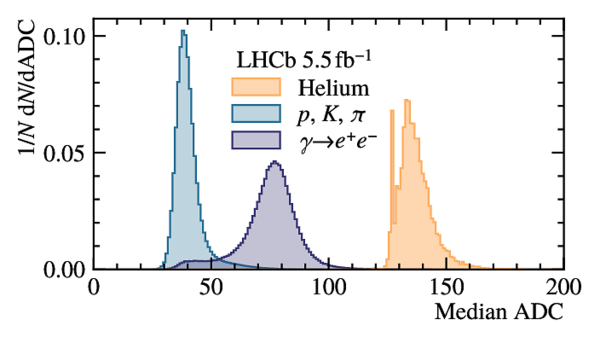
|
|
|
Distributions of the number of overflows for simulated helium signal and $Z=1$ particles from calibration data . The vertical line indicates the preselection requirement. |
Fig2.pdf [15 KiB] HiDef png [118 KiB] Thumbnail [102 KiB] |

|
|
Distributions of the cluster amplitudes, for different cluster sizes, in the $ {\rm VELO } R$ sensors for (left) simulated helium signal and (right) calibration data . |
Fig3a.pdf [40 KiB] HiDef png [226 KiB] Thumbnail [142 KiB] |

|
|
Fig3b.pdf [40 KiB] HiDef png [201 KiB] Thumbnail [121 KiB] |

|
|
|
Distributions of $\Lambda_{\rm LD}^{{\rm VELO } R}$ in: (left) samples of $Z=1$ tracks from calibration data and simulated helium; (right) samples of hadrons from $ B ^0 \rightarrow K ^{*0} ( K ^+ \pi ^- ) J/\psi(\mu^+ \mu^-)$ decays. The simulation is normalised to the data. |
Fig4a.pdf [172 KiB] HiDef png [160 KiB] Thumbnail [109 KiB] |
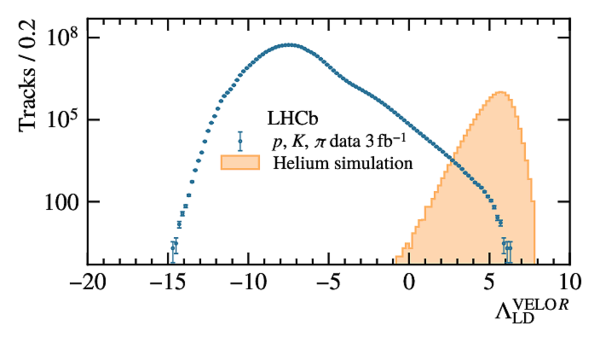
|
|
Fig4b.pdf [143 KiB] HiDef png [187 KiB] Thumbnail [129 KiB] |
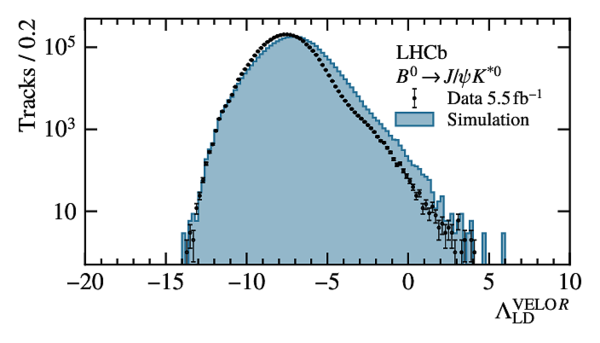
|
|
|
Distributions of the log-likelihood estimators from the LHCb VELO ( $\Lambda_{\rm LD}^{\rm VELO }$ ), TT ( $\Lambda_{\rm LD}^{\rm TT }$ ) and IT ( $\Lambda_{\rm LD}^{\rm IT }$ ) silicon trackers from the minimum-bias data. {Helium candidates are indicated by green boxes.} Left: the tracks are required to pass the selection described in \Cref{sec:tracktime} or to have $\Lambda_{\rm LD}^{\rm IT } >-1$. Right: the tracks must traverse the IT and have $\Lambda_{\rm LD}^{\rm VELO } >0$. The full selection described in \Cref{sec:tracktime,sec:photons,sec:ipchisq} is applied. |
Fig5a.pdf [70 KiB] HiDef png [675 KiB] Thumbnail [314 KiB] |
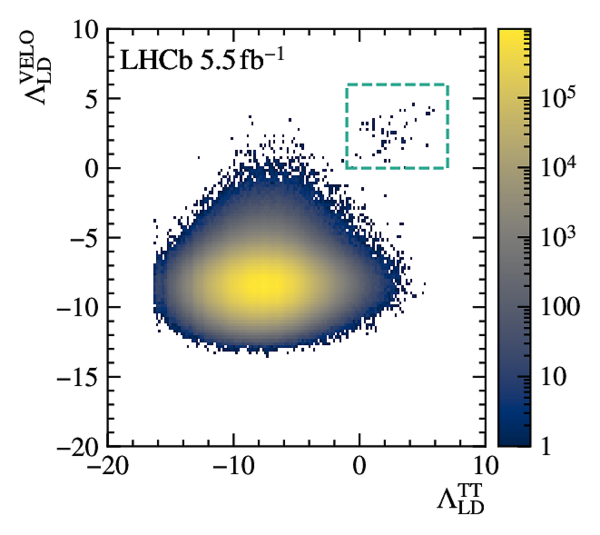
|
|
Fig5b.pdf [45 KiB] HiDef png [179 KiB] Thumbnail [137 KiB] |

|
|
|
Left: Efficiency matrix of the two preselections determined from the helium candidates selected in minimum-bias data. Right: Distribution of the number of overflows in helium candidate tracks from minimum-bias data and $Z=1$ particles from calibration data . The latter is normalised to 25% of the former. The requirement used in the preselection is shown {by the vertical dashed line}. |
Fig6a.pdf [14 KiB] HiDef png [166 KiB] Thumbnail [130 KiB] |

|
|
Fig6b.pdf [15 KiB] HiDef png [111 KiB] Thumbnail [97 KiB] |

|
|
|
{Left: sketch of the LHCb tracking detectors and magnet; adapted from Ref. [12]. Right:} Distribution of the reference track time versus the momentum for tracks with $\Lambda_{\rm LD}^{\rm VELO } >0$ and $\Lambda_{\rm LD}^{\rm TT } >1$. In each momentum slice, the distribution is normalised to unity and fitted with a Gaussian function. The positions of the means is indicated by the black dots. These are fitted as described in the main body, resulting in the shape depicted by the green continuous line. The {dashed} green lines indicate the $\pm 1$ $\text{ ns}$ interval. |
Fig7a.pdf [10 KiB] HiDef png [88 KiB] Thumbnail [68 KiB] |
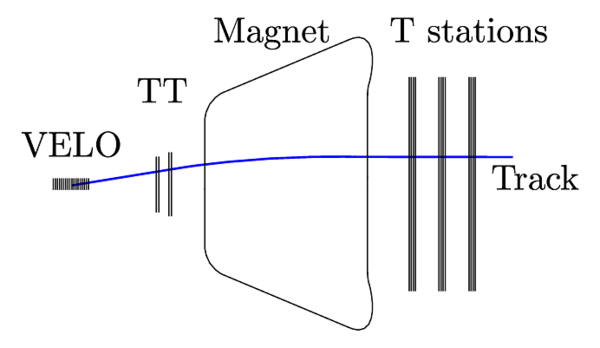
|
|
Fig7b.pdf [45 KiB] HiDef png [946 KiB] Thumbnail [433 KiB] |
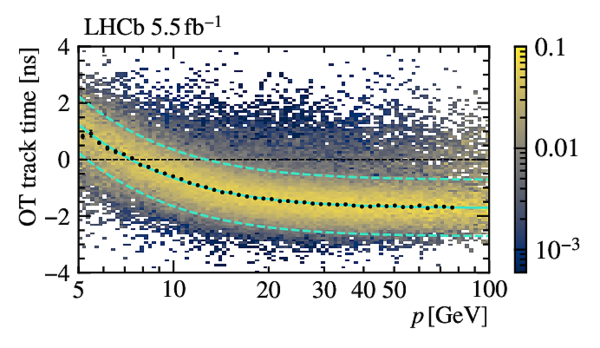
|
|
|
Distribution of the RICH electron-pion separation estimator ( $\Lambda_{e-\pi}^{\rm RICH}$ ) for helium signal and background below the rigidity thresholds for Cherenkov photon production by $ ^3{\rm He}$ in the two LHCb RICH detectors. The vertical dashed line indicates the selection requirement. |
Fig8.pdf [21 KiB] HiDef png [181 KiB] Thumbnail [148 KiB] |

|
|
Distributions of the log-likelihood estimators from the LHCb VELO ( $\Lambda_{\rm LD}^{\rm VELO }$ ), TT ( $\Lambda_{\rm LD}^{\rm TT }$ ) and IT ( $\Lambda_{\rm LD}^{\rm IT }$ ) silicon trackers. Left: the tracks are required to pass the downstream selection. Right: the tracks must traverse the IT and have $\Lambda_{\rm LD}^{\rm VELO } >0$. On the left, the signal region is denoted by A, whilst regions B, C, and D correspond to background. |
Fig9a.pdf [81 KiB] HiDef png [1 MiB] Thumbnail [401 KiB] |
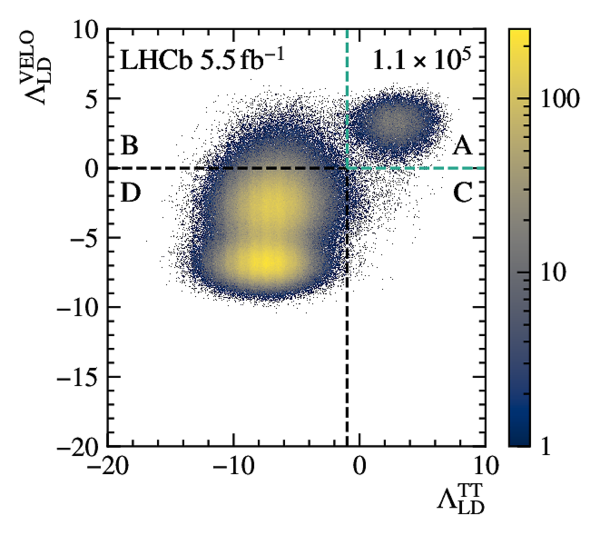
|
|
Fig9b.pdf [37 KiB] HiDef png [601 KiB] Thumbnail [254 KiB] |
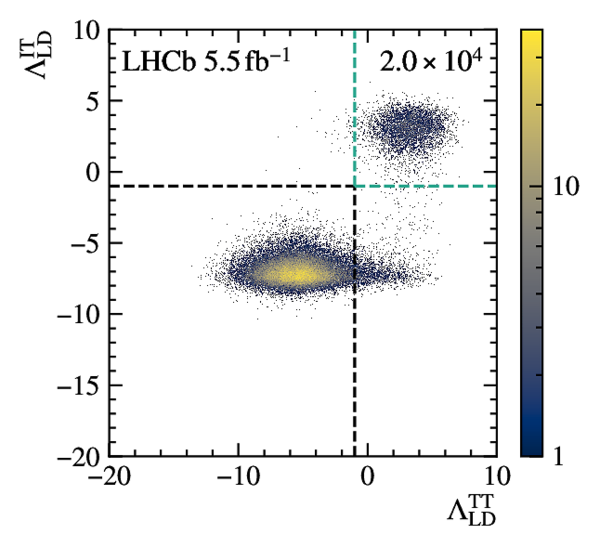
|
|
|
Distributions corresponding to that on the left-hand side of \Cref{fig:LLDsABCD}, but separated into tracks of (left) positive and (right) negative charge. |
Fig10a.pdf [77 KiB] HiDef png [1 MiB] Thumbnail [398 KiB] |

|
|
Fig10b.pdf [76 KiB] HiDef png [1 MiB] Thumbnail [395 KiB] |
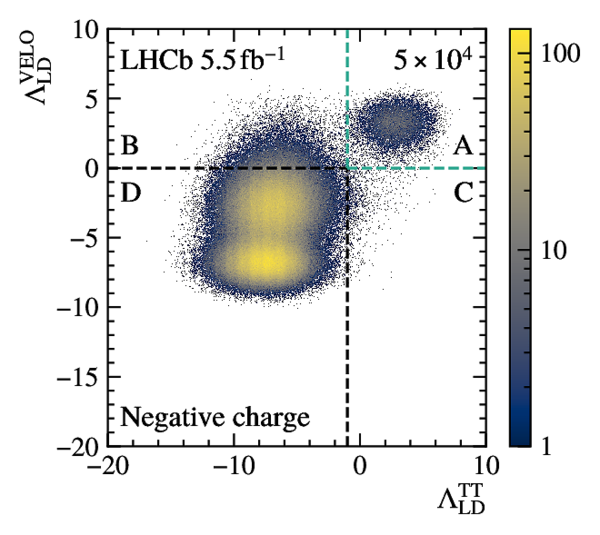
|
|
|
Distribution of $\Lambda_{\rm LD}^{\rm VELO }$ as a function of momentum (left) and pseudorapidity (right), in data from both preselections combined. Tracks are required to pass the selection in \Cref{sec:tracktime}, as well as $\Lambda_{\rm LD}^{\rm TT } >-1$. Each vertical slice is normalised to unity. |
Fig11a.pdf [53 KiB] HiDef png [841 KiB] Thumbnail [306 KiB] |

|
|
Fig11b.pdf [48 KiB] HiDef png [762 KiB] Thumbnail [270 KiB] |
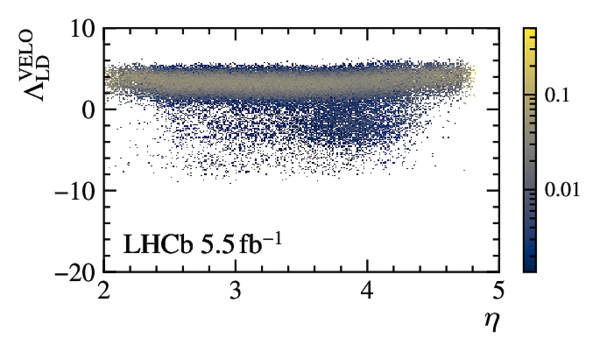
|
|
|
Distribution of the natural logarithm of the $\chi^2_{\text{IP}}$ for helium and antihelium tracks, combining data from both preselections. The requirement that separates prompt and displaced helium is shown {by the vertical dashed line}. |
Fig12.pdf [18 KiB] HiDef png [191 KiB] Thumbnail [123 KiB] |

|
|
Distribution of $\Lambda_{\rm LD}^{\rm VELO }$ in (left) helium and (right) antihelium samples from the (upper) preselection 2 and (lower) preselection 1 data samples. The distribution from an independent background sample is shown in blue, scaled to match the size of the populations found in data at negative $\Lambda_{\rm LD}^{\rm VELO }$ values. To visualise the background in the preselection 1 sample, the inset of each bottom-row plot shows a magnification of the region $\Lambda_{\rm LD}^{\rm VELO } \in[-10, 1]$. Each inset's horizontal axis matches that of the containing plot. |
Fig13a.pdf [49 KiB] HiDef png [172 KiB] Thumbnail [133 KiB] |

|
|
Fig13b.pdf [37 KiB] HiDef png [139 KiB] Thumbnail [101 KiB] |
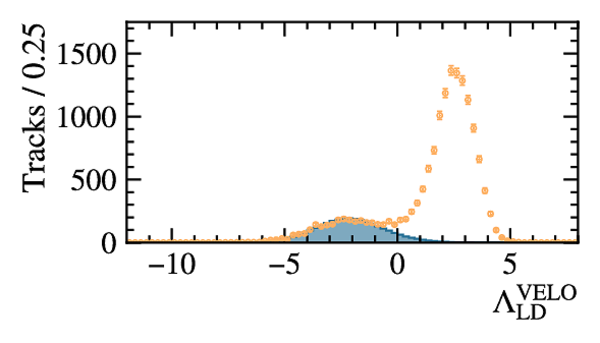
|
|
|
Fig13c.pdf [51 KiB] HiDef png [195 KiB] Thumbnail [127 KiB] |

|
|
|
Fig13d.pdf [51 KiB] HiDef png [196 KiB] Thumbnail [128 KiB] |

|
|
|
Animated gif made out of all figures. |
DP-2023-002.gif Thumbnail |

|
Tables and captions
|
Helium selection criteria quantified throughout this paper. The logical or is required between the two preselection criteria. Given the complementary acceptances of OT and IT, the logical or is also required between the downstream requirements. |
Table_1.pdf [75 KiB] HiDef png [100 KiB] Thumbnail [48 KiB] tex code |

|
Created on 18 May 2024.
